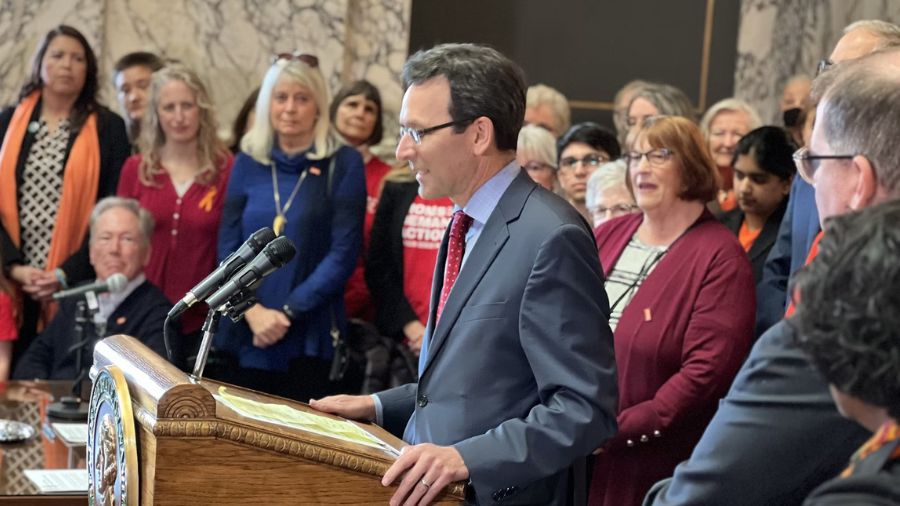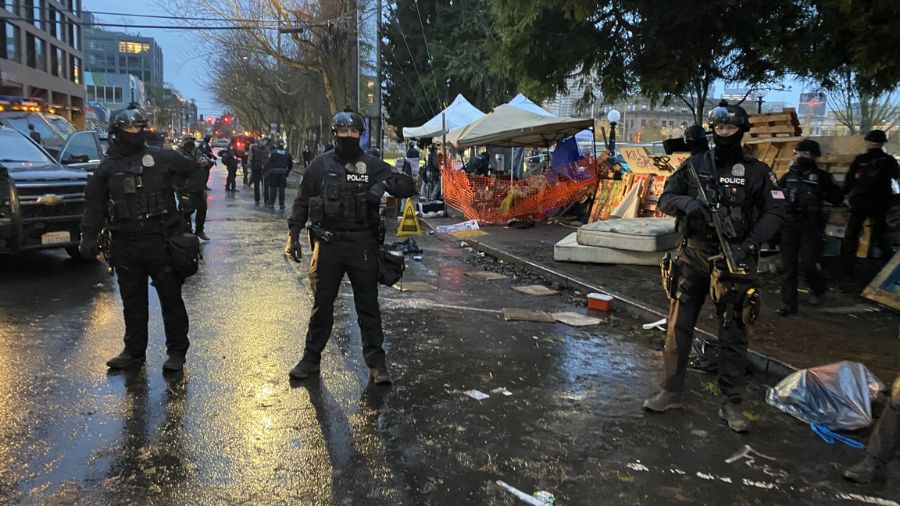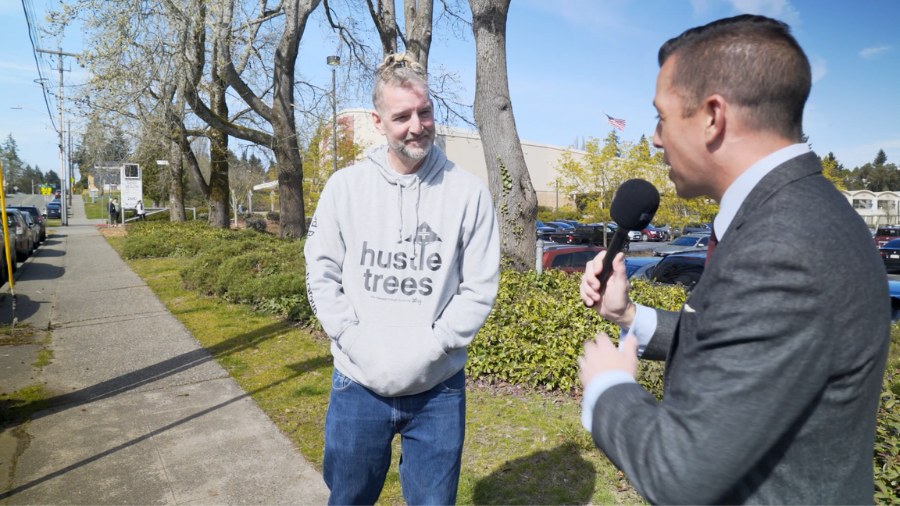Rantz: Seattle progressives say arresting black or Native American suspects is racist and ‘troubling’
Apr 19, 2022, 7:21 PM | Updated: Apr 20, 2022, 12:54 pm

Seattle police at a crime scene after a fatal shooting on Capitol Hill in March 2022. (Photo courtesy of SPD Blotter)
(Photo courtesy of SPD Blotter)
Seattle progressives believe black or Native American criminals should get a pass. In fact, if you arrest them, you’re maintaining a systemically racist police department. It’s the latest unsurprising position from activists specializing in identity politics and dangerous wokeness.
According to a new report by the federal monitor that oversees the department, Seattle Police engaged in historically low use of force in 2021. SPD’s use of force declined 33% between 2015 and 2019 and almost 50% between 2015 and 2021. Force can include pushing someone away from a victim, using a taser or firearm, and putting someone in handcuffs.
You would think police critics would celebrate this data. But in the name of equity, activists focus on an uncomfortable truth: more black and Native American suspects committed crimes in Seattle during the study that required police intervention.
Equitable policing means progressives want to give certain criminals a pass
Activists in and out of elected office complain that the SPD is arresting too many black and Native American suspects. They appear to believe that racial data on arrests should match that group’s proportion of the local demographic.
Local media is calling attention to this portion of the report: “the distribution of use of force across races does not resemble the racial makeup of Seattle, with Black subjects and American Indian subjects comprising a larger portion of use of force subjects when compared to their share of the population.”
Seattle Mayor Bruce Harrell says the data is “troubling” yet simultaneously claims he’s not pre-judging the data.
“It’s troubling that people of color, in particular African Americans, are still the recipient of force in disparate numbers,” Harrell told KOMO. “I’m not going to prematurely reach any conclusions but as you well know, I drafted and passed a biased-free policing law, so this is near and dear to me.”
Is the use of force supposed to match the racial demographics of Seattle? Or is the implication that whites, Asians, and Latinos are getting a pass for crimes they’re committing because of a very specific kind of racism that only impacts black and Native Americans?
No one outside of the most extreme anti-police activists argues the crimes not being committed; that police are making up reasons to use force against black or Native American suspects. They’re complaining that cops are simply using force against criminals who happen to be black or Native Americans.
Rantz: Washington State Patrol rips KING 5 for slanted segment, but agency is to blame
Here’s what the data says
As a KING 5 reported, “the most serious types of use-of-force incidents were most often focused on Black individuals.” Indeed, the report states:
Black subjects were involved in the highest number of the most serious types of force (Type III, including officer shootings) with 18, followed by White subjects and subjects of “unknown” race (15), and Asian subjects (6).
This data doesn’t make a judgment call on whether or not the use of force was warranted. This merely suggests that black suspects are accused of committing serious crimes at a disproportionately high rate relative to their population share. The raw data also shows the most serious force is rarely used by police.
Bad faith activists claim that pointing out this data is somehow racist; that you’re saying only black people are committing serious crimes. But no one argues that. This very data shows other racial groups commit crimes officers reasonably believe requires use of force, just not at the same levels (or at least there aren’t the same 911 calls for officers to respond to those crimes). This isn’t a condemnation of black Seattleites; it’s just explaining what the data says.
Lazy journalists and lazier activists frequently offer gripes about disproportionality. If any group (other than cis-gendered white men) is disproportionately impacted negatively, the claim is that there must be some systemic bigotry involved. They rarely provide evidence to back the claims beyond simply saying a group is disproportionately impacted. It’s a strategy used by dishonest people to convince ignorant people that something nefarious is happening.
Black people make up 7% of Seattle's total population, but 54% of all the people shot by our cops.
After ten years of expensive "reform" under a federal monitor because of racist policing, and here we are. You can't "reform" this. We tried. https://t.co/3Jc9JLl7Pp
— NTK (@ntkallday) April 13, 2022
Rantz: Thousands of your tax dollars went to phony Black Lives Matter ‘art’
There’s no bias alleged here
The report makes it crystal clear: “SPD officer use of force roughly matches arrest rates across races.” In other words, people are being treated equally.
“White subjects represented 55% of arrests and 54% of uses of force; black subjects represented 36% of arrests and uses of force; Asian subjects represented 5% of arrests and uses of force. American Indians were the only group with a notable difference, representing 1% of subjects of force and 2.8% of arrests. SPD officer use of force roughly matches arrest rates across races.”
It’s worth noting that the Native American data represents only 32 use of force incidents.
The report also notes that white suspects got hurt more often than black suspects — again, an odd result for an allegedly racist organization.
“A higher percentage of White subjects were reported to be injured during force encounters than Black subjects during each of the years from 2015 through 2021,” the report says. It likely means white suspects were more likely to resist arrest in ways that necessitated more aggressive force.
The report even notes that officers pointing firearms at black suspects “have decreased most significantly” with a “73% decrease of pointings of lethal firearms at Black individuals from 2015 (304 pointings) to 2019-2021 (average of 82).”
To many activists, most of the data is irrelevant.
They ultimately believe that SPD arrest data should reflect the city’s racial demographics. That is, if the black population in Seattle is 7%, you should see roughly a 7% arrest rate for black suspects. In order to have arrest data match the demographic population, you’d have to tell officers to stop arresting people who are committing crimes at disproportionate rates.
Rantz: Seattle theater manager disciplined for celebrating murder of Everett officer?
Activists prevent the right conversations
Officers don’t have control over who is committing crimes requiring the use of force.
The implication that somehow they should stop arresting criminal suspects based on skin color is both absurd and dangerous. If white people were committing crimes requiring the use of force at disproportionately higher rates relative to their population share, should they not face the consequences because it could create some kind of equity imbalance? Of course not.
If activists believe whites, Asians, or Latinos are committing crimes but not paying the price due to anti-black or anti-Native American racism, then the argument should be to fire racist cops and arrest more white, Asian or Latino criminals. The response shouldn’t be to say — implicitly or explicitly — that we should stop arresting criminals who happen to be black or Native American. Data showing more arrests for black and Native American people are not a substitute for evidence of racist or biased policing.
If black or Native Americans face higher arrests because they are in neighborhoods with more police, it doesn’t mean the crimes they’re arrested for didn’t occur. Arguing for less policing in neighborhoods with higher crime leads to more victims and even more crime. If white, Asian, or Latino communities face fewer arrests because there aren’t many police patrolling those neighborhoods and crime is actually occurring, the response should be to hire more police officers to patrol those neighborhoods.
Criminals should be arrested regardless of their skin color. This concept is only controversial to the most fringe of our community.
Click here to view the Seattle Police Monitor Use of Force Preliminary Assessment
Listen to the Jason Rantz Show weekday afternoons from 3–6 pm on KTTH 770 AM (HD Radio 97.3 FM HD-Channel 3). Subscribe to the podcast here. Follow @JasonRantz on Twitter, Instagram, Facebook, and YouTube. Check back frequently for more news and analysis.














